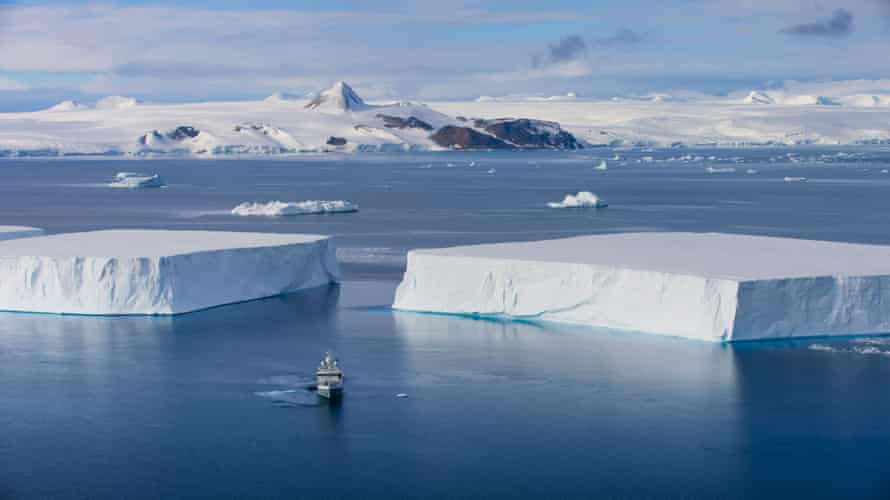It was after her mother died that Catherine Kelly learned the healing power of water. Following instincts that she did not yet understand, she moved to live alone by the sea in County Mayo, on the west coast of Ireland, and over the next few years began to heal. “It’s an ebb and flow that water gives us that allows us to connect with ourselves. It’s an allowing,” she says.
After eight years studying the therapeutic effects of nature, she has written a book called Blue Spaces, packed with ideas about how to make the most of being in or near water. You don’t have to live near the coast to benefit. “There’s being in it, being next to it, thinking about it,” she says. Nor does it matter how much water is available. From raindrops to the ocean, urban fountains to canals and fast-moving rivers, there is a blue space for everyone. And although the phrase “blue space” typically refers to natural waters, Kelly says the possibilities for meaningful connection are the same whether it is the sea or your shower.
“Being in the water brings you straight into your body,” she says. “I think that’s the crux of the wellbeing benefit of water: it brings you out of your head. You cannot ignore your body when water is pounding on top of you.”
Here are some tips to help you make the most of blue space – wherever you are.
Listen to a fountain
The movement and sound of the water draw people in, Kelly says. Fountains are a great example of how water can spur a meditative encounter without requiring a person to make a self-conscious or formal effort to be mindful. Kelly likes to sit by a fountain and notice, then filter out all other sounds. “Focus on the water … That helps us to feel calmer inside,” she says. It doesn’t matter whether it is a fountain in a public square or in the privacy of your own garden pond. With practice, the skill of filtering out sounds can be transferred to busy households and home offices.
Hit the cold tap

Follow the Wim Hof method and accustom yourself to a blast of unmixed cold at the end of your shower. Start with 10 seconds and build up to a minute of exposure. If the full-body experience is more than you can manage, Kelly says that even splashing your face with cold water has benefits: the cold stimulates the vagus nerve and triggers an “anti-inflammatory response that helps with anxiety and depression. It improves circulation and releases endorphins.”
Go to the coast
Kelly’s favourite watery landscape is the sea. “I throw myself in every chance I get,” she says. Different types of sea are effective for different moods: during lockdown, with work and schooling colliding at home, she yearned for a rough sea. “It took my frustrations out of me – pulled them out, threw me around and made me laugh,” she says. On calmer days, she enjoys swimming into the sunstream, where the sun lights up a path on a still sea. The key is to navigate your emotional geography.
Eye the horizon
You could also sit on shingle, or eat an ice-cream while walking along a prom. There is nothing like a horizon to give a sense of freedom and perspective. “Seeing ourselves in a coastal space allows us to let go of things in a way that other spaces don’t,” Kelly says. “Here I am, this small thing. So my problems are maybe not that big after all.”
Join a wild-swimming community

Even if you have a swimmable lake, river or pool within reach, it can still feel hard to take that first step. Kellym who now lives in Brighton, is a member of a group called the Salty Seabirds; the Outdoor Swimming Society lists groups nationwide. As Kelly says: “Access to water is about more than the water just being there.” Social barriers can feel prohibitive, but wild-swimming communities on social media or local networking sites can offer an easier, companionable point of entry.
Find the right water for you
While some people love to swim in the sea, others feel unwelcomed by its vastness and its variable currents and conditions. “Some people like the contained space of a lake,” Kelly says. She likes the wildness of unpredictable spaces and has enjoyed swimming in the Glenariff waterfalls, in the glens of County Antrim, on visits to extended family in Northern Ireland. Others “find peacefulness in water that’s surrounded by greenery”, while some love to walk by (or kayak in) a canal.
Take a bath

What makes a bath such a great escape for those who live miles from bathing water is the chance “to design the water the way you want it”, says Kelly. For her, that means bath oils, a candle, rainforest music and about an hour’s free time. She suggests getting in slowly, to appreciate how the water feels on your skin. “For people who are comfortable, a quick dunk is a great release. I recommend holding your breath and just dipping right under,” she says. Repeat once or twice and feel the water carry away stress.
Use your imagination
It is possible to find blue space in your imagination. As Kelly says, we can mirror the effects of water by thinking about it. When my little one can’t fall asleep, I walk him down our favourite valley in Cornwall, beside a stream that leads to a rocky cove. When the tale of the journey ends, with spray on our noses and the taste of salt on our tongues, at least one of us has fallen asleep.
Made-up places work just as well. Kelly likes to invite people to picture themselves walking on a beach. Soft sand slips between the toes and grows claggy nearer the sea. Waves lap at feet. In the distance, a hammock has been thoughtfully strung between two trees, symbolising the past and the future. Climb into the hammock and settle into the present. “What this does is kick in the parasympathetic nervous system,” Kelly says. “It brings down your heart rate. When you are meditating, your stress responses can’t work.”
Pick up a pebble

Any pebble. It doesn’t have to be from a beach. Find one in the park or your garden, if you have one. Since I am obsessed with pebbles, I have a pot of favourites on my desk. Study the stone. Run your fingers and thumbs over it. Examine its imperfections. Kelly says she loves “the metaphor of pebbles … On a beach, you can take one pebble and know you’re connected to the whole lot. They make an entity together: one stone can dam a little bit of water, but a whole beach can work much better.”
Don’t judge rain

If the weather is wet, try not to complain; take a moment to appreciate the chance to watch the water cycle in action. Going for a walk in rain can be invigorating. Kelly’s idea of putting on a swimsuit and standing out in the garden in a downpour is a stretch for me, but I have happily raced through a hilltop village in a rainstorm when the steep streets resembled waterfalls. If you hate getting wet, sit indoors and enjoy the sound of it falling while you stay dry, or pick a couple of raindrops and watch them race to the bottom of your window. “Blue-space thinking allows us to reframe ourselves,” Kelly says. “Instead of thinking: ‘Oh no, it’s raining’, think: ‘Well, there is water.’ I’m a big fan of non-judging, which allows us to notice things and not react to them.”
Embrace watery culture

Watching David Attenborough’s Blue Planet, or other oceanic documentaries, such as My Octopus Teacher, can connect you to blue space by offering the opportunity to experience it vicariously. Reading books of other people’s watery journeys (such as I Found My Tribe by Ruth Fitzmaurice, The Salt Path by Raynor Wing, or How to Read Water by Tristan Gooley), listening to ocean sounds from a speaker in your living room or – why not? – trying out a spot of watercolour painting can all take you into the realm of blue space.
Give something back
If you do get to a body of water, whether it is a canal, a lake or the beach, take a litter picker with you. As Kelly says: “It’s my place. It’s my water. I want to look after it.”
Blue Spaces: How & Why Water Can Make You Feel Better by Catherine Kelly is published on 29 April (Welbeck Publishing Group, GBP14.99). To order a copy, go to guardianbookshop.com. Delivery charges may apply.